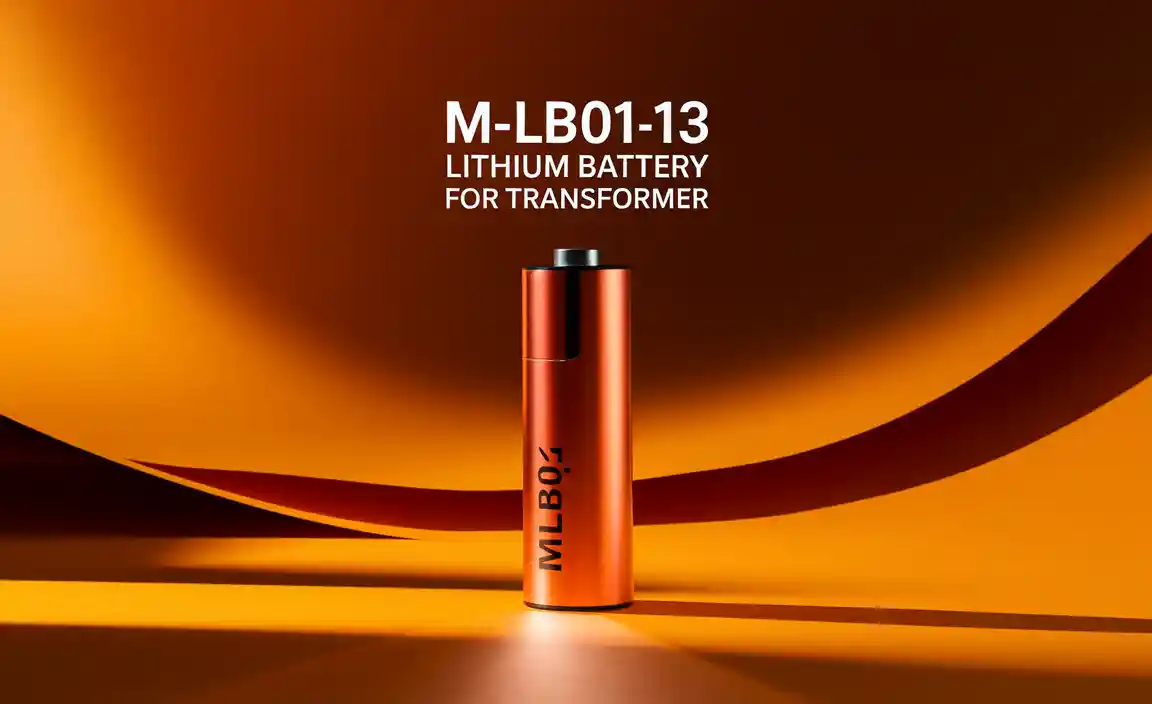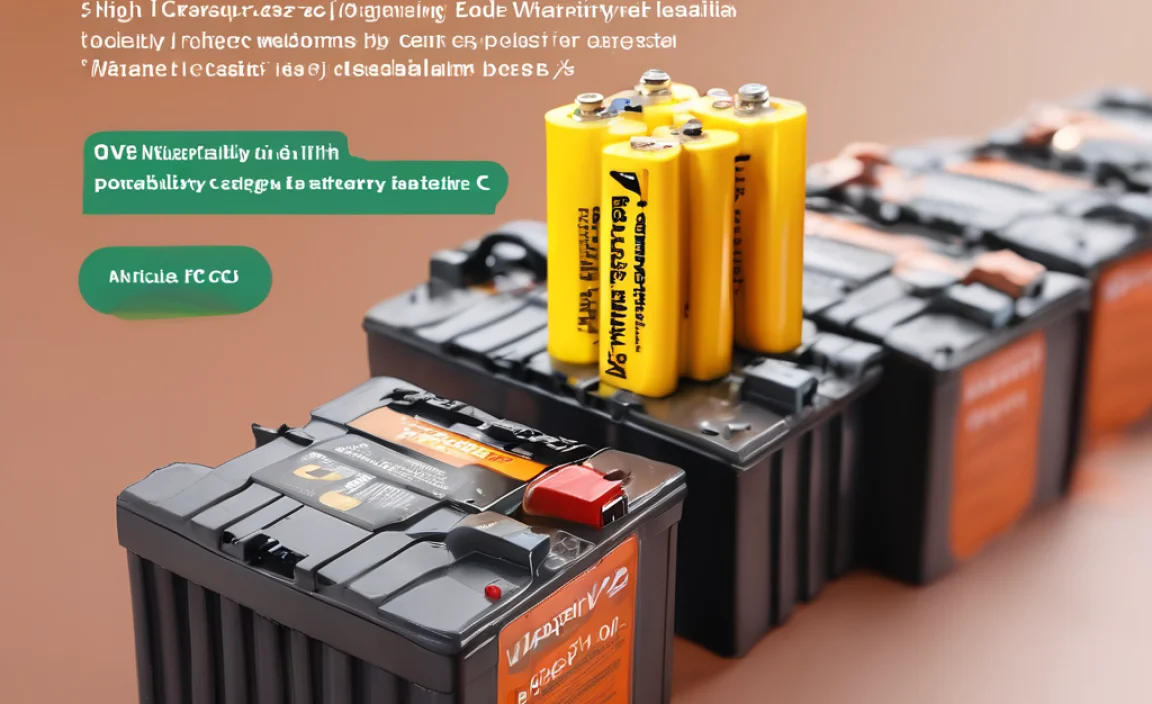A marine battery box for 2 batteries secures and protects your essential power sources on boats, ensuring reliable performance and safety. This guide will help you choose and install the right one.
Keeping your boat’s power system running smoothly is super important, and your batteries are the heart of it all. When you need more power, like for longer trips or running more equipment, you might use two batteries. But just having them sitting there isn’t ideal. They need a safe, sturdy home! That’s where a marine battery box designed for two batteries comes in. It’s like giving your important power sources a secure garage. Don’t worry if this sounds complicated, I’m here to break it down simply. We’ll look at why you need one, how to pick the best one, and how to get it set up. Let’s get your boat powered up safely and efficiently!
Why You Need a Marine Battery Box for Two Batteries
Think of your boat batteries like the muscles of your vessel. They provide the energy for starting the engine, running your lights, navigation gear, and all those other essential devices that make your time on the water enjoyable and safe. When you decide to double up on batteries to increase your boat’s power capacity, you’re essentially adding more muscle. However, this also means you need a robust way to manage and safeguard that added power.
A properly chosen marine battery box does more than just hold your batteries. It’s a critical piece of safety equipment. Batteries, especially if they’re not secured, can jostle around with the motion of the waves. This movement can cause several problems:
- Short Circuits: Acid can leak, and terminals can come into contact with metal, creating dangerous sparks or even fires.
- Damage to Batteries: Physical bumps and vibrations can damage the internal components of the batteries, shortening their lifespan and leading to costly replacements.
- Spills and Fumes: Batteries can release corrosive acid and explosive gases. A good box contains these, protecting you and your boat’s structure.
- Electrical System Issues: Loose connections due to movement can cause intermittent power failures, which is never good when you’re out on the water.
A marine battery box specifically designed for two batteries offers a consolidated and secure solution. It keeps the batteries together, prevents them from sliding, and provides ventilation while containing any potential leaks. This is especially crucial for maintaining the integrity of your boat’s electrical system and ensuring your safety.
Choosing the Right Marine Battery Box for Two Batteries
Selecting the perfect battery box isn’t just about finding one that fits. Several factors make one box better for your specific needs than another. Let’s walk through what to consider.
Size and Fit Matters
This is the most obvious, but also the most important. You need a box that comfortably fits two of your specific marine batteries. Marine batteries come in different sizes, commonly referred to by Group numbers (like Group 24, 27, 31, etc.). These groups dictate the physical dimensions. Measure your batteries or check their labels to know their size.
A good two-battery box should have internal dimensions that accommodate two batteries side-by-side or stacked securely. Make sure there’s enough room for the batteries themselves, plus a bit of extra space for cables and connections. You don’t want the box to be so tight that you can’t get the batteries in or out, but it shouldn’t be so loose that the batteries can still move around inside. Many manufacturers provide detailed dimension charts for their boxes.
Material and Durability
Marine environments are harsh. Saltwater, sun, and constant exposure to the elements mean the materials need to be tough. Most quality marine battery boxes are made from durable, impact-resistant plastics like polyethylene. This material is lightweight, won’t corrode like metal, and can withstand significant knocks and UV exposure.
Look for boxes that are certified for marine use. This means they’ve been tested to withstand the rigors of boating. Features like reinforced corners, sturdy lid latches, and a solid base add to the overall durability and longevity of the box.
Ventilation
Batteries, especially when charging, can produce hydrogen gas. This gas is explosive! A good marine battery box needs adequate ventilation to allow this gas to escape safely. Look for boxes with vents that are designed to keep water out while allowing air to flow. Some boxes have built-in vents, while others rely on the fit of the lid or pre-drilled holes you might need to add.
It’s a good idea to check if the box meets standards for containing battery acid and allowing proper ventilation. Regulations from organizations like the US Coast Guard provide guidelines on this. For instance, the U.S. Coast Guard’s Marine Safety Manual offers insights into equipment safety requirements for vessels.
Secure Mounting and Lid
The box itself needs to be securely fastened to your boat. Most boxes come with a mounting system or pre-drilled holes for straps or bolts. Ensure the box has a robust way to be attached so it doesn’t become a projectile in rough seas. Straps are common and effective; they should be stout and able to hold the weight of two batteries plus the box securely.
The lid is another critical component. It should fit snugly and have strong latches that won’t pop open easily due to vibration or movement. Many lids are designed to lift off or hinge open, making access for maintenance or battery replacement straightforward.
Acid Containment
Accidental leaks are a serious concern. A good battery box should have a built-in lip or tray at the bottom to contain any acid that might leak from the batteries. This prevents corrosive acid from damaging your boat’s hull, electrical components, and deck surfaces.
Type of Battery Box (Ventilated vs. Sealed)
While ventilation is key, the purpose of the box is also to contain potential spills. Most marine battery boxes are designed to be ventilated to release gases but also to capture leaked acid. You generally want a “vented” box to prevent gas buildup.
Some boxes might be marketed as “sealed,” but in a marine context, proper ventilation for gas escape is still paramount. Always ensure your box has a mechanism for gas to exit safely.
Essential Features to Look For
When you’re browsing for that perfect two-battery marine box, keep these features in mind. They’ll make your life easier and your power system safer.
- Sturdy Handles: For easier carrying when installing or performing maintenance.
- Built-in Battery Trays/Dividers: Some boxes have specific slots or dividers to keep two batteries perfectly positioned and prevent them from touching each other directly.
- Cable Glands/Openings: Pre-made openings or knock-outs for routing your battery cables neatly and safely.
- UV Resistance: Important if the box will be exposed to direct sunlight.
- Compliance with Standards: Look for boxes that meet ABYC (American Boat and Yacht Council) standards or Coast Guard requirements for safety and materials.
Installation: Step-by-Step Guide
Installing a marine battery box for two batteries is a fairly straightforward DIY project. With a few basic tools and careful attention, you can have it secured and ready to go.
Tools and Materials You’ll Need
- The marine battery box for two batteries
- Two marine batteries (correct size and type)
- Battery terminal connectors (if not already on your cables)
- Marine-grade battery cables (appropriate length and gauge)
- Wrench set (for tightening straps and bolts)
- Drill and drill bits (if mounting with screws/bolts)
- Screws or bolts appropriate for your boat’s material (e.g., stainless steel)
- Sealant (marine-grade, if needed for mounting holes)
- Wire brush (for cleaning terminals)
- Battery terminal protector spray/grease
- Safety glasses
- Gloves
Step 1: Prepare the Batteries and Cables
Before placing the batteries into the box, ensure their terminals are clean. Use a wire brush to scrub away any corrosion. If your battery cables don’t have crimped-on terminals, attach them now. Make sure the connections are tight and secure. It’s also a good idea to apply a thin layer of battery terminal protector spray or grease to prevent future corrosion.
Step 2: Position the Battery Box
Decide where you want to install the battery box. This location should be well-ventilated, accessible for maintenance, and sturdy enough to support the weight of two batteries. Avoid areas where fuel lines or other critical systems are routed, to minimize risk in the unlikely event of a battery issue.
Place the empty battery box in its intended spot. You might want to test fit it with the batteries inside to ensure clearance for opening the lid and running cables.
Step 3: Secure the Battery Box
This is a critical safety step. The box must be firmly attached to the boat’s structure. Most boxes come with mounting holes or a strap system.
- Straps: If using straps, thread them through the designated slots in the box and secure them to strong points on your boat. Ensure the straps are tight and the box cannot slide or lift unexpectedly.
- Bolts/Screws: If the box has mounting feet or holes, mark the positions on your boat’s surface. Drill pilot holes if necessary. Use marine-grade stainless steel screws or bolts to firmly attach the box. If drilling into fiberglass, it’s good practice to seal the holes with marine-grade caulk or epoxy to prevent water intrusion.
The goal is to make the box immoveable, even in rough water.
Step 4: Install the Batteries
Carefully place the two batteries into the box. If they have specific orientations for terminals, ensure they are placed correctly. Many two-battery boxes are designed to place batteries side-by-side. If your box has internal dividers or trays, use them to keep the batteries spaced and stable. Make sure the batteries are sitting flat and securely.
Step 5: Connect the Battery Cables
This is where you’ll hook up your batteries to your boat’s electrical system. You typically connect two batteries in one of two ways for increased capacity or voltage:
- Series Connection (for higher voltage): Connect the positive (+) terminal of one battery to the negative (-) terminal of the other. Then, connect your main positive cable to the remaining positive (+) terminal, and your main negative cable to the remaining negative (-) terminal. This doubles the voltage (e.g., two 12V batteries become a 24V system).
- Parallel Connection (for higher capacity): Connect the positive (+) terminal of one battery to the positive (+) terminal of the other battery. Do the same for the negative (-) terminals. Then, connect your main positive cable to one of the joined positive terminals, and your main negative cable to one of the joined negative terminals. This keeps the voltage the same (e.g., 12V) but doubles the amp-hour capacity.
Ensure all connections are clean, tight, and insulated. Use appropriate marine-grade cables of the correct gauge. It’s vital to get this right for both safety and performance. If in doubt about wiring, consult a marine electrician.
For a visual guide on series and parallel battery connections, resources like BatteryStuff.com offer helpful diagrams and explanations suitable for DIYers.
Step 6: Route Cables and Secure the Lid
Use the cable glands or openings on the battery box to route your cables. Secure any extra cable length to prevent it from snagging. Close the lid of the battery box. Ensure the latches are securely fastened. If the lid is removable, make sure it’s sitting flush and securely so it doesn’t come off during operation.
Step 7: Final Check
Give everything a once-over. Wiggle the box to ensure it’s still secure. Check that all cable connections are tight. Make sure no tools or loose items are left inside or around the battery area. Test your boat’s electrical systems to confirm everything is working as expected.
Maintenance and Safety Tips
Owning a marine battery box means you’re taking a smart step towards battery longevity and safety. But like any equipment, a little ongoing care makes a big difference.
Regular Inspection
Make it a habit to check your battery box and batteries regularly, especially before and after significant trips.
- Inspect the Box: Look for any cracks, damage, or wear and tear on the box itself or its latches and straps.
- Check Connections: Ensure all cable connections to the battery terminals are tight and free of corrosion.
- Look for Leaks: Check the bottom of the box for any signs of acid leaks. Clean up spills immediately with a baking soda and water mixture, then rinse thoroughly.
- Ventilation: Make sure the vents on the box are clear and not blocked by dirt, salt, or debris.
Cleaning
If you notice any build-up of dirt, salt spray, or residue on the battery box or batteries, clean them gently. A soft brush and a mild soap-and-water solution usually do the trick. Rinse thoroughly and dry. Avoid using harsh chemicals that could damage the plastic or the battery casing.
Charging Practices
Proper charging is key to battery health. Always use a marine-specific battery charger designed for the type of batteries you have (e.g., flooded, AGM, gel). Ensure the charger is compatible with multiple batteries if you connect them in series or parallel. Follow the charger manufacturer’s instructions carefully.
Overcharging or undercharging can damage batteries and, in extreme cases, lead to dangerous situations like overheating or excessive gas production. A good marine battery charger will have features to prevent these issues.
Emergency Preparedness
In the unlikely event of an acid spill or other emergency:
- Safety First: Always wear gloves and eye protection when working near batteries.
- Neutralize Acid: Keep a mixture of baking soda and water (about 1 cup baking soda to 1 gallon of water) handy to neutralize any spilled battery acid.
- Ventilation: Ensure the area is well-ventilated whenever you are working with batteries or charging them.
- Fire Safety: Have a marine-rated fire extinguisher readily accessible on your boat.
For more detailed safety information regarding battery handling and storage, the Blue Sea Systems website offers excellent technical specifications and safety guidelines for their marine electrical products, including battery boxes.
Pros and Cons of a Two-Battery System Box
Pros:
- Increased Power Capacity: Allows for longer run times and powering more accessories.
- Enhanced Reliability: Having a second battery can provide a backup in case one fails.
- Improved Starting Power: Especially beneficial for larger engines or in colder climates.
- Secure and Safe Storage: Protects batteries from damage and contains leaks and fumes.
- Organized System: Keeps two batteries neatly housed and connected.
- Meets Regulations: Many marine boxes are designed to comply with safety standards.
Cons:
- Increased Weight: Two batteries are significantly heavier than one.
- Higher Cost: The initial purchase of two batteries and a suitable box is more expensive.
- More Complex Wiring: Connecting two batteries correctly requires understanding series vs. parallel configurations.
- More Space Required: Needs adequate space on the boat to house the larger box.
- Maintenance: Requires more attention to ensure both batteries are maintained and charged properly.
Alternatives and Considerations
While a dedicated marine battery box for two batteries is excellent, what if your needs are different or your space is limited? Here are a few related thoughts.
Single Large Battery
For some boats, a single, larger battery (like a deep-cycle G-31 or G-27) might offer enough capacity without the complexity of a dual-battery setup. However, for demanding applications, two batteries are often superior.
Battery Switches and Selector Systems
If you have two batteries, you’ll likely want a battery switch. This allows you to select which battery to draw power from, run both, or isolate them. This is crucial for managing power and ensuring you can start your engine even if one battery is depleted. Some advanced systems offer automatic charging and switching.
Battery Management Systems (BMS)
While more common in lithium-ion systems, advanced battery management systems





